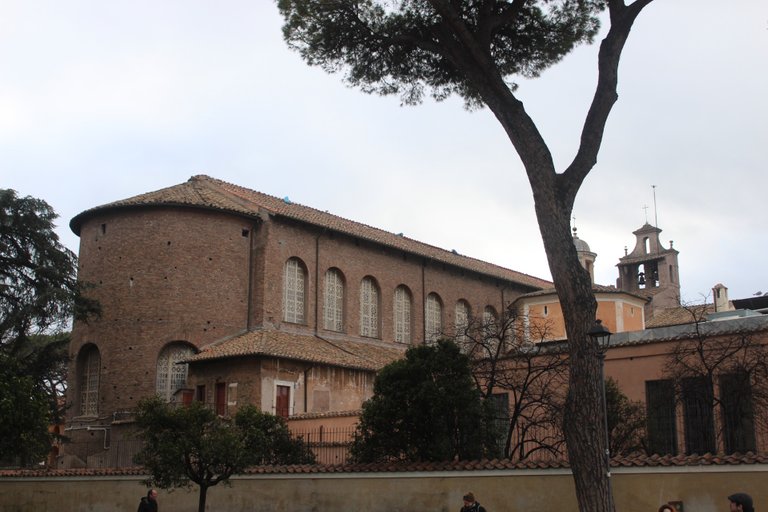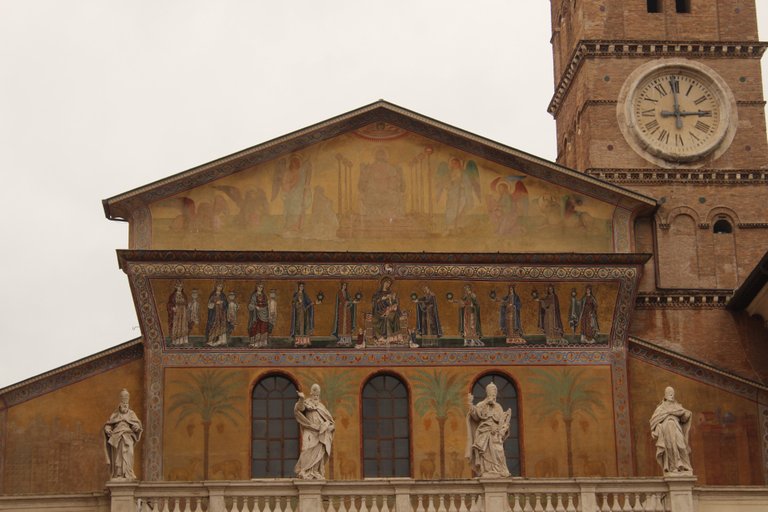[ENG]
During our stay in Rome, we did two things to our head. The first is eating the local pizza, because we like pizza, so every day some pizza landed on our plates, and the second most common activity was visiting Roman churches. It is said that there are over 900 churches in Rome, and I think it is very possible because during these few days of walking around the city we passed by at least a hundred different churches. I have already described the most famous church in Rome, i.e. the Basilica of St. Peter in the Vatican, the oldest structure that is currently a church, i.e. the Pantheon, I have described the baroque churches of Rome, and all four larger basilicas. I have one more, very old and unusual church up my sleeve, which in my opinion deserves a separate comment, and smaller basilicas to which this entry will be devoted.
[PL]
Podczas naszego pobytu w Rzymie robiliśmy głowie dwie rzeczy. Pierwsza to jedzenie tamtejszej pizzy, bo bardzo lubimy pizzę, więc codziennie na naszych talerzach lądowała jakaś pizza, a drugim najczęstszym zajęciem było zwiedzanie rzymskich kościołów. Mawia się, że w Rzymie znajduje się ponad 900 kościołów, i uważam, że to jest bardzo możliwe bo przez te kilka dni chodzenia po mieście przeszliśmy obok co najmniej stu różnych kościołów. Opisywałem już najsłynniejszy kościół Rzymu, czyli bazylikę św. Piotra w Watykanie, najstarszą konstrukcje będąca obecnie kościołem, czyli Panteon, opisałem barokowe kościoły Rzymu, oraz wszystkie cztery bazyliki większe. W zanadrzu mam jeszcze jeden bardzo stary i nietypowy kościół, który w mojej ocenie zasługuje na osobny komentarz, oraz bazyliki mniejsze, którym będzie poświęcony ten wpis.
[ENG]
Church of st. Sabina on Aventine we visited by accident, because it is very close to the beautiful garden of Giardino degli Aranci with a beautiful panorama of Rome, so being so close it would be a sin not to go inside. The church was built in the years 425-432 as a three-nave basilica dedicated to St. Sabina. In 1219, Pope Honorius III donated the building to St. Dominic, who expanded the temple and founded his Dominican monastery in it. The temple is entered through a portal with original cedar doors from the 5th century. The naves of the church are separated by two rows of ancient columns in the Corinthian order. There is also one interesting legend connected with the temple, about a devil's stone, which Satan was to throw at the praying in the temple of St. Dominica. A stone throw caused a slab on the floor to crack, and this stone is still exhibited in the basilica today.
[PL]
Babylike św. Sabiny na Awentynie odwiedziliśmy trochę przypadkiem, gdyż znajduje się bardzo blisko pięknego ogrodu z Giardino degli Aranci z przepiękną panoramą Rzymu, więc będąc już tak blisko grzechem byłoby nie wstąpić do środka. Kościół został zbudowany w latach 425-432 jako trójnawowa bazylika poświęcona św. Sabinie. W 1219 papież Honoriusz III przekazał budynek św. Dominikowi, który rozbudował świątynię i założył w nim swój klasztor dominikański. Do świątyni wchodzi się przez portal z oryginalnymi cedrowymi drzwiami pochodzącymi z V wieku. Nawy kościoła oddzielone są od siebie dwoma rzędami antycznych kolumn w porządku korynckim. Z świątynią wiąże się też jedna ciekawa legenda, o czarcim kamieniu, którym to szatan miał rzucić w modlącego się w świątyni św. Dominika. Rzut kamieniem spowodował pęknięcie płyty na posadce, a ów kamień jest do dzisiaj eksponowany w bazylice.
[ENG]
Another basilica that made a particularly good impression on us is the Basilica of St. The Roman Pontiffs built on the ruins of the ancient temple of Venus and Roma. It is located in the immediate vicinity of the ancient Roman Forum. Built in the middle of the 8th century, on the initiative of Pope Paul, however, as a result of the earthquake of 847, the temple fell into ruin and only in 1161 under Pope Alexander III, a thorough renovation of the church was carried out. In the basilica under the altar is buried Francis of Rome, whose popularity after the canonization of 1609 increased the rank of the basilica, thanks to which it was decided to make a new facade, designed by Carlo Lombardi. The mosaic of the Mother of God with the Child surrounded by the apostles James, John, Peter and Andrew, dated to the year 1161 in the apse shell, made the greatest impression on me in the interior of the temple.
[PL]
Kolejną bazyliką, która zrobiła na nas szczególnie dobre wrażenie to Bazylika św. Franciszki Rzymianki zbudowany na ruinach starożytnej świątyni Wenus i Romy. Znajduje się on w bezpośrednim sąsiedztwie antycznego Forum Romanum. Zbudowana w połowie VIII wieku, z inicjatywy papieża Pawła jednak w wyniku trzęsienia ziemi z roku 847 świątynia popadła w ruinę i dopiero w roku 1161 za papieża Aleksandra III przeprowadzono gruntowną renowację kościoła. W bazylice pod ołtarzem pochowana jest Franciszka Rzymianka, której popularność po kanonizacji z 1609 roku wpłynęła na podniesienie rangi bazyliki, dzięki czemu podjęto decyzje o wykonaniu nowej fasadę, którą zaprojektował Carlo Lombardi. Największe wrażenie we wnętrzu świątyni zrobiła na mnie datowana na rok 1161 znajdująca się w muszli apsydy mozaika przedstawiająca Matkę Bożą z Dzieciątkiem w otoczeniu apostołów Jakuba, Jana, Piotra i Andrzeja.
[ENG]
The last basilica we visited during our visit to Rome was the Basilica of the Blessed Virgin Mary in Trastevere. Trastevere is famous for its numerous restaurants where ordinary residents of the city, not tourists, supposedly dine, which makes the dishes cheaper and tastier. I must admit that this is true, but returning to the basilica, it must be noted that it is one of the oldest temples in all of Rome. According to legend, the building was built on the initiative of St. Callixtus I in the years 217-222, however, some sources claim that there was no temple here at that time, and prayer meetings were held in the house of St. Callixtus I and only in the years 340-352 Julius I built a basilica here. In 1291, Pietro Cavallini decorated the facade of the church with mosaics, which are now the most characteristic element of the temple. The mosaic in the upper part of the facade shows the enthroned Mother of God, two kneeling founders of the temple and 10 female figures, symbolizing the Wise and Stupid virgins known to us from one of the Gospel parables. In 1920, during renovation works, ancient ruins were discovered under the floor of the residential buildings originally located here, which may confirm the theory that the place of the temple was first home to the house of Pope Callixtus I.
[PL]
Ostatnią bazyliką, którą odwiedziliśmy podczas wizyty w Rzymie była Bazylika Najświętszej Maryi Panny na Zatybrzu. Zatybrze słynie z licznych restauracji w których rzekomo stołują się zwykli mieszkańcy miasta, a nie turyści, przez co potrawy w nich serwowane, są tańsze i smaczniejsze. Muszę przyznać, że to prawda, ale wracając do bazyliki trzeba zaznaczyć, że jest to jedna z najstarszych świątyń w całym Rzymie. Według legendy budowla powstała z inicjatywy św. Kalikst I w latach 217-222, jednak niektóre źródła twierdzą, że wówczas nie było tutaj świątyni, a spotkania modlitewne odbywały się w domu św. Kalikst I i dopiero w latach 340 -352 Juliusz I zbudował tutaj bazylikę. W 1291 Pietro Cavallini ozdobił fasadę kościoła mozaikami, które obecnie stanowią najbardziej charakterystyczny element świątyni. Mozaika znajdująca się w górnej części fasady przedstawia tronującą Matkę Bożą, dwóch klęczących fundatorów świątyni i 10 postaci kobiecych, symbolizujących panny Mądre i Głupie znane nam z jednej z ewangelicznych przypowieści. W 1920 roku podczas prac remontowych odkryto pod posadzką antyczne ruiny pierwotnie znajdującej się tutaj zabudowy mieszkaniowej, co może potwierdzać teorię, że w miejscu świątyni najpierw znajdował się dom papieża Kaliksta I.






















❤️🇮🇹❤️🇮🇹
Ive been there last June, the details are amazing, the colours and the dedication to the Christianism is incredible!
Nice photos!
Congratulations, your post has been added to Pinmapple! 🎉🥳🍍
Did you know you have your own profile map?
And every post has their own map too!
Want to have your post on the map too?
Congratulations @olusiu! Your post made the TravelFeed team happy so we have sent you our big smile. Keep up the good job. 😃
Thanks for using TravelFeed!
@jpphotography (TravelFeed team)
PS: Have you joined our Discord yet? This is where over 1000 members of the TravelFeed come together to chat. Join us!